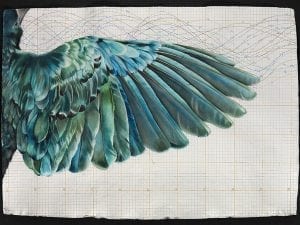Karen Thomas is a British artist based in Montpellier, France. Her dynamic, painterly depictions of pop culture icons and characters such as Mickey Mouse and Jane Fonda are characterised by their thick, quick brush strokes. These new pieces rely on the paint to earn its place on the surface by giving it the freedom to tell much of the story with an energetic trust. She has shown both individually and in group exhibitions at the RA Summer Exhibition, The Other Art Fair and Art Below London, SELECT Art Fair, New York, and the Berliner Liste, Berlin. We interview the painter:
A: A lot of your work features characters many people would associate with their childhood – Donald Duck and Mickey Mouse. What is the motivation behind this nostalgic approach?
KT: I grew up with Disney, Top of the Pops, James Bond and Elvis films – I still have a 1960s Super 8 filmed at Disneyland, California so it’s easy for me to call on these “source” images. They still have real currency in modern popular culture, giving them a transgenerational appeal. I don’t think it’s so much to do with nostalgia. In the past I have revisited “weightier” works – Courbet’s Baigneuses, Vélasquez or Frans Hals’ The Laughing Cavalier. I have now adopted a lighter, more informal approach, but it’s still a development of what has gone before.
A: Your painting style seems to have changed quite a lot in recent years. How did this new style evolve?
KT: As a painter, I enjoy the challenge of addressing new themes which impose different constraints. Every collaboration is a new journey: I’m not always sure where I’m going to end up, but that’s what’s interesting. I began painting in France in the late 80s when the Figuration Libre movement was le dernier cri and so I was influenced by that at the time. I painted with a thick black outline, cartoon style or Bande Dessinée as it’s called here. Over the years I’ve moved away from that but there are still elements of it in my work.
Each project has led to development and change, whether in subject, size, medium or surface. I have been fortunate to have had the opportunity to work on a diverse range of projects, from illustrating a previously unpublished text by Jean Cocteau, to designing a set for a contemporary dancer or creating portraits of fifty people from my neighbourhood with a writer. I am as much shaped by my projects as they are shaped by me.
A: One of the main features of this new style, from a viewer’s perspective at least, is your obscuring of your subjects. Could you talk a little about this technique?
KT: Although the figures are out of context and abstracted from reality, their essence is apparent. They are easily identifiable in much the same way as a logo and it is this moment of recognition that engages audiences, provoking interactive responses.
A: The majority of your shows are divided between France and the UK, with other shows in the USA and Germany. Do you feel there is a difference in audience reaction to your work in the UK compared to France?
KT: In France I am not generally in direct contact with the public although I am lucky to have built up a number of dedicated followers over the years. I have only recently had the opportunity to show my work in London and Germany but I really enjoy the combination of work and wanderlust! It was an immense privilege to be selected for the Royal Academy Summer Exhibition 2014 and to have my painting featured on the BBC2 documentary by Kirsty Wark. Another work, The Young Queen, was shortlisted this year.
Participating in The Other Art fair, Art Below, the Berliner Liste, and Kate Garner’s Elephant Haven auction were also very positive and energising experiences. They introduced me to audiences who were enthusiastic and showed genuine interest. I now have works in galleries in Devon and Brighton and will be at the Affordable Art Fair, Hamburg, in November with the Galerie Nimmesgern, Starnberg.
A: You recently released a series of collectible postcard size images. What were the benefits and challenges of working on that small scale?
KT: Small scale work always used to be difficult; I was used to producing larger canvases – I first started to work on the postcard size images to send to charity shows such as Visual Aids in New York and The International Postcard Show at the Surface gallery in Nottingham. After that they became compulsive and I have been producing a whole series.
They are physically accessible and have been quite successful: the first time they were shown at The Other Art Fair a number of visitors actually took them off the wall! The added advantage of working on this scale is that a whole exhibition can be stored in a shoebox or sent in an envelope, no need for crates or shipping!
Explore Karen’s work at www.karen-thomas.org.
To see her listing in the Artists’ Directory in Aesthetica Magazine issue 66 pick up a copy at www.aestheticamagazine.com
Follow us on Twitter @AestheticaMag for the latest news in contemporary art and culture
Credits:
1. Man on the Moon, Pink Mickey and Elvis (2013-14). Courtesy of the artist.
2. Jane Fonda, Annie Oakley and Wonder Woman (2013-14). Courtesy of the artist.




